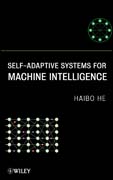
This book will advance the understanding and application of self-adaptive intelligent systems; therefore it will potentially benefit the long-term goal of replicating certain levels of brain-like intelligence in complex and networkedengineering systems. It will provide new approaches for adaptive systems within uncertain environments. This will provide an opportunity to evaluate the strengths and weaknesses of the current state-of-the-art of knowledge, give riseto new research directions, and educate future professionals in this domain. Self-adaptive intelligent systems have wide applications from military security systems to civilian daily life. In this book, different application problems, including pattern recognition, classification, image recovery, and sequence learning, will be presented to show the capability of the proposed systems in learning, memory, and prediction. Therefore, this book will also provide potential new solutions to many real-world applications. INDICE: Preface. Acknowledgments. Chapter 1. Introduction. 1.1 The MachineIntelligence Research. 1.2 The Two-Fold Objectives: Data-Driven and Biologically-Inspired Approaches. 1.3 How to Read this Book. 1.4 Summary and Further Reading. References. Chapter 2. Incremental Learning. 2.1 Introduction. 2.2 Problem Foundation. 2.3 An Adaptive Incremental Learning Framework. 2.4 Design of the Mapping Function. 2.5 Case Study. 2.6 Summary. Chapter 3. Imbalanced Learning. 3.1 Introduction. 3.2 Nature of the Imbalanced Learning. 3.3 Solutions for Imbalanced Learning. 3.4 Assessment Metrics for Imbalanced Learning. 3.5 Opportunities and Challenges. 3.6 Case Study. 3.7 Summary. Chapter 4. Ensemble Learning. 4.1 Introduction. 4.2 Hypothesis Diversity. 4.3 Developing Multiple Hypotheses. 4.4 Integrating Multiple Hypotheses. 4.5 Case Study. 4.6 Summary. Chapter 5. Adaptive Dynamic Programming for Machine Intelligence. 5.1 Introduction. 5.2 Fundamental Objectives: Optimization and Prediction. 5.3 ADP for Machine Intelligence. 5.4 Case Study. 5.5 Summary. Chapter 6. Associative Learning.6.1 Introduction. 6.2 Associative Learning Mechanism. 6.3 Associative Learning in Hierarchical Neural Networks. 6.4 Case Study. 6.5 Summary. Chapter 7. Sequence Learning. 7.1 Introduction. 7.2 Foundations for Sequence Learning. 7.3 Sequence Learning in Hierarchical Neural Structure. 7.4 Level 0: A Modified Hebbian Learning Architecture. 7.5 Level 1 to Level N: Sequence Storage, Prediction and Retrieval. 7.6 Memory Requirement. 7.7 Learning and Anticipation of Multiple Sequences. 7.8 Case Study. 7.9 Summary. Chapter 8. Hardware Design for Machine Intelligence. 8.1 A Final Comment. References.
- ISBN: 978-0-470-34396-8
- Editorial: John Wiley & Sons
- Encuadernacion: Cartoné
- Páginas: 248
- Fecha Publicación: 24/06/2011
- Nº Volúmenes: 1
- Idioma: Inglés
